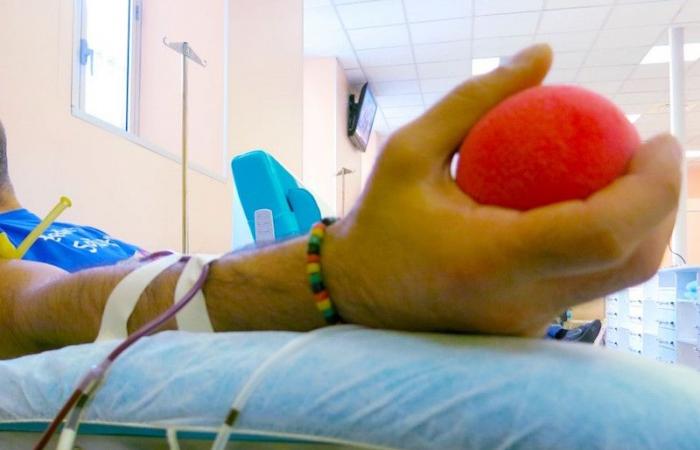
Spotlight on blood donations. The regional day took place this year in Lucca, in the headquarters of the IMT School of Advanced Studies and the event on 15 June was an opportunity to draw up a balance sheet but also to trace the future routes of the transfusion system, focusing one by one on the challenges on the horizon: skills and organization of healthcare facilities, the value and importance of a free gift, the fundamental role of voluntary associations. With the help also of a study that the IMT of Lucca carried out together with Avis for the two-year period 2018-2020.
The numbers are encouraging, at least in Tuscany. After the pandemic, 2023 was a year of recovery. In fact, 206 thousand donations were exceeded in the region, forty-five per thousand residents (only for the production of red blood cells) against a national target of forty. A success whose first credit goes to the 116 thousand donors active during the year. In Italy only 2.7 percent of Italians are donors – the data are from the National Blood Center and refer to 2022 – compared to 2 million 800 thousand transfusions benefiting 639 thousand patients.
Also the trend recorded in the first months of 2024 is positive in Tuscany. The growth in donations has in fact remained constant and marked a further increase of 10 percent: for red blood cells, where Italy has achieved self-sufficiency, but also for plasma, where donations are historically fewer but important because they are fundamental for the production of life-saving drugs such as immunoglobulins, albumin or coagulation factors.
Numbers growing, but there are still some critical demographic issues (but not only) which cannot be overlooked: donors age and those who, between eighteen and forty-five years of age, should replace them decrease. Generational change is not enough. Then there is the question of summer, a period in which there is a physiological decline in donations and blood begins to run low. However, in Tuscany in 2023, thanks to the careful and coordinated work of all the players in the Tuscan blood system, no emergency situations were recorded and the blood system operated in self-sufficiency. “This year too we were ahead of the game – he comments the councilor for the right to health, Simone Bezzini -. With the Regional Blood Centre, the local health authorities and the donor associations we have worked on a strategy to prevent an emergency from occurring in our hospitals in the summer months. A summer without blood loss means no slowdown on the healthcare system, but also careful work on the appropriate use of this precious resource and the health of patients”.
Tuscany, in fact, confirms itself as one of the most virtuous regions at a national level, the result of teamwork involving the Regional Blood Centre, healthcare companies and voluntary associations.
“The results are thanks to the commitment of the voluntary associations and the generosity of the donors. A big thank you goes to them on behalf of the Tuscany Region – comments Bezzini -. We will continue to work alongside the professionals of the blood system and the associations, ensuring a strengthening of the structures and continuing to pay particular attention to this driving sector of the healthcare system”.
“The Italian transfusion system – he explains Ennio Bilancini, professor of behavioral economics at the Imt School – is based, on the one hand, on the competence and commitment of the professionals and healthcare facilities involved, and on the other on the gratuitousness and voluntariness of the donation, an act motivated primarily by ethical values and supported by voluntary associations. The research conducted at the IMT Scuola Alti Studi Lucca aims to provide the most modern tools to facilitate the work of healthcare professionals and structures, also using artificial intelligence, and at the same time to understand how to support and promote the values and ethics of donation, also thanks to innovative policies”.
Who can donate to whom
Blood donation is open to all citizens, Italian and foreign. You must be at least eighteen years old and no more than seventy, have good health, have a correct lifestyle and be of adequate weight. The presence of certain pathologies, ongoing therapies, recent travel or operations may lead to permanent exclusion or temporary suspension from donation. You can donate at three-month intervals (but no more than twice a year for women of childbearing age).
There are four different blood groups – group A, B, Ab and zero – which double depending on the presence or absence of a specific antigen, Rh, on the surface of the red blood cells. The 0 Rh negative group is definitively universal: with some exceptions, it can be donated to any individual; but those who have it can only receive blood from an O negative donor. The rh positive AB group, on the other hand, can receive blood donations from all groups.
In Italy, the distribution varies depending on the geographical area, it is estimated that the O positive group is the largest and runs through the veins of 39-40 percent of the population. Immediately after there is the positive group A, found in 36 percent. This is followed by group B positive (7.5 percent), 0 negative (7 percent), AB positive (2.5 percent), A negative (6 percent), B negative (1, 5 percent) and negative AB (the rarest in Italy, with 0.5 percent of cases in the population).
Source: Tuscany Region – Press office



